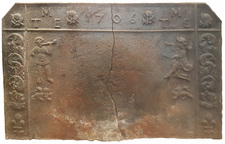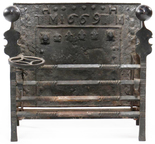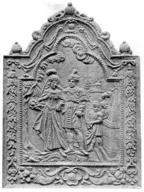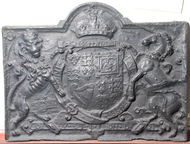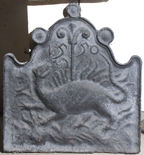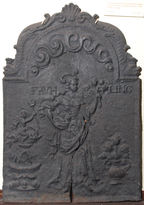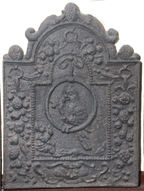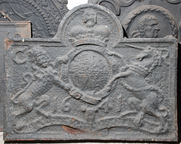-
841
Description: Canted rectangle; cavetto-moulded edging (top and sides); single horizontal fillet below canted corners and vertical fillet parallel to each side, dividing the fireback into two side panels, two top corner panels, top panel and main central panel; corner panels, ‘daisy’ plant stamp; top panel, date between ‘daisy’ stamps, between initials in triad at each end; side panels, swirling foliage stamp repeated each side above a fleur-de-lys; centre panel, stamp of ‘Indian’ smoking a pipe at top left, stamp of seated ‘gentleman’ smoking a pipe and holding another, at top right; below each, a lion passant stamp, facing right on the left and facing left on the right; initials IB in bottom corners of centre panel.
Notes: The 'daisy' stamp is identical to those on similar firebacks dated between 1703 and 1721, and probably indicating the same founder whose initials IB are at the bottom; the use of stamps relating to tobacco smoking may suggest an origin near Bristol, the main entry port for the tobacco trade at that time. Previously noted at Little Faringdon House, near Lechlade. Bishop & Miller auction, Stowmarket, Suffolk, 25 May 2022, lot 293 (ns).
Inscription: TME [triad] 1706 TME [triad] / I B
- Decoration tags:
- rectangular with canted top corners (shape)
- cavetto (edging)
- carved stamps
- individual letters
- individual numbers
- heraldic
- text
- animals
- humans
- plants
- objects
Manufactured: in 1706 in the Forest of Dean area of England.
Current location: not known.
- Attached to series:
- IB series
- Fleur-de-lys firebacks
-
1097
Description: Rectangular; cavetto-moulded edging; [?]fillet frame parallel with edging; on top, central date between two groups of initials in triad, with six 'daisy heads' above; on each side, vertical line of at least four squared cross stamps; inside frame, four fleurs-de-lys between two oval 'buttons' on a rectangular base at least five 'daisy heads' in a vertical line on each side.
Notes: A significant fireback, it comprises decorative stamps from at least three series of firebacks produced in the Forest of Dean area, linking their production to the same ironworks. The same fireback (or copies thereof), with and without the attached grate, was illustrated in catalogues issued c1910-21 by Arthur Todhunter, architectural antiques dealer, of New York (catalogue #919, $50). Leland Little auction, Hillsborough, North Carolina, 3 Mar 2018, lot 260, $400.
Inscription: THM [triad] 1669 THM [triad]
- Decoration tags:
- rectangular (shape)
- cavetto (edging)
- carved stamps
- individual letters
- individual numbers
- heraldic
- text
- objects
Manufactured: in 1669 possibly at Elmbridge Furnace, Newent in the Forest of Dean area of England.
Current location: not known.
-
863
Description: Arched rectangular central panel with additional arch above; bead and fillet edging; pictorial scene of, on the left, a tree next to a female and, in the centre, a male figure, both in eastern dress, a page behind holding a train, and to the right a short obelisk surmounted by a crescent, behind which is the head of a figure with a camel; behind is a small building also surmounted by a crescent, with clouds above; the word, ASIA, is centre bottom; identical shaped border with cavetto-moulded edging; a pomegranate on top with descending swags of drapery; at the sides, overlapping bunches of foliage suspended from ribbon bows; at the bottom, a central cartouche between fruit bunches; on top, a pomegranate with a descending serpent on each side, and a pomegranate on each shoulder of the plate.
Notes: A pastiche of the EUROPA design based on an engraving c.1642 of Friedrich Wilhelm, Elector of Brandenburg, and his wife, Luise Henriette of Oranje-Nassau, by Mathias Czwiczek, with the figures adopting very similar poses in an oriental setting; one of a series depicting allegories of the four continents.
Copies of this fireback are known.
Inscription: ASIA / MB
- Decoration tags:
- 'Dutch' (shape)
- cavetto (edging)
- whole carved pattern
- pictorial
- allegorical
- monogram
- text
- humans
Manufactured: in the mid- to late-17th century possibly in the Siegerland area of Germany.
Current location: not known.
- Attached to series:
- 'Dutch' Arched arch types
- 'Dutch' Continents firebacks
-
392
Description: Arched rectangular shape; cavetto moulding on all sides, with short gaps at each end of the base (possibly to accommodate firedogs); date in top corners; shield, supporters, coronet and motto of the Barony of Bergavenny: Gules, on a saltire argent, a rose of the field, barbed and seeded proper. The motto, ‘Ne vile velis’ (Wish nothing base) is a pun on the family name.
Notes: The arms are those of William Nevill, 16th Baron Bergavenny, of Kidbrooke Park, Forest Row, Sussex. The date of the fireback coincides with the completion of the mansion. Formerly part of the J. H. Every collection.
Copies of this fireback are known.
Inscription: 1736 / NE VILE VELIS
Arms: William Nevill, 16th Baron Bergavenny
- Decoration tags:
- rectangular with round arch (shape)
- cavetto (edging)
- whole carved pattern
- individual numbers
- armorial
- text
Manufactured: in 1736 in the Weald area of England.
Current location: Anne of Cleves House, Southover High Street, Lewes, East Sussex, England.
Museum number: 1944.24.086 (part of the Sussex Archaeological Society museum group)
Citation: Hughes, G. B., 21 Apr 1955, 'Old English Firebacks', Country Life, 117, pp. 1056-60.
- Attached to series:
- Bergavenny firebacks
- Personal armorial firebacks
-
405
Description: Arched rectangular shape with small rhomboidal flanges in the corners of the arch; cavetto moulded edge on all sides; Stuart royal arms (1605-88, 1702-14) with lion and unicorn supporters, garter, crown and motto; raised inscription in a tapering label beneath crown.
Notes: An amended copy of a 17th/early 18th century original (see no. 633). The added inscription has been impressed with the personalised cast handle of a cooking vessel. A bronze skillet bearing the inscription 'STANDEN 1726' on its handle has been recorded elsewhere, but the impression on the fireback has been formed from a handle with the inscription inset in relief, whereas the 1726 inscription is inscribed. Also the lettering on the handle used to personalise the fireback, which includes the letter A surmounted with a horizontal line, is of an earlier style. Three members of the Standen family, Thomas, James and Elias, were founders at Beech or Robertsbridge furnaces, Sussex, 1728-9, and a John Standen was casting skillets at Heathfield Furnace in the early 1730s; each could have been the founder of the 1726 skillet, but the maker of the handle used in the fireback casting may have been earlier. Formerly at Marshalls Manor House, Maresfield, Sussex.
Inscription: IAMES STANDEN [+Garter and royal mottoes]
Arms: English Stuart royal
- Decoration tags:
- rectangular with round arch (shape)
- cavetto (edging)
- carved pattern panels
- whole carved pattern
- armorial
- royal
- text
Manufactured: in the late-17th to early-18th century in the Weald area of England.
Current location: Anne of Cleves House, Southover High Street, Lewes, East Sussex, England.
Museum number: LH000.943 (part of the Sussex Archaeological Society museum group)
Citation: Dawson, C., 1903, 'Sussex Iron Work and Pottery', Sussex Archaeological Collections, 46, pp. 1-54.
- Attached to series:
- Stuart royal armorial firebacks
- Miscellaneous stamp firebacks
-
407
Description: Quasi-arched rectangular shaped; unique, cavetto moulded edging, which loops upon itself three times. A mythical salamander shown in the flames which legend states it is able to resist; behind is what appears to be a palm tree, on either side of which the date is stamped.
Notes: The fireback has been incorrectly dated 1550 instead of 1650, which Schubert, following W. R. Lethaby, asserted was a forgery claiming indications that a ‘6’ had been erased. Undoubtedly the first '5' is more prominent than the other figures though the exact method by which it has been substituted is not clear. Corrosion to the bottom right corner may have obliterated a letter 'M' seen on another casting; presumably part of 'IM'.
Inscription: 1550
- Decoration tags:
- rectangular with ornate arch (shape)
- cavetto (edging)
- whole carved pattern
- individual numbers
- pictorial
- mythological
- text
- animals
Manufactured: in 1650 possibly at Brede Furnace in the Weald area of England.
Current location: Anne of Cleves House, Southover High Street, Lewes, East Sussex, England.
Museum number: LH000.901 (part of the Sussex Archaeological Society museum group)
Citation: Dawson, C., 1903, 'Sussex Iron Work and Pottery', Sussex Archaeological Collections, 46, pp. 1-54.
Citation: Gardner, J. S., 1898, 'Iron Casting in the Weald', Archaeologia, 56, 1, pp. 133-164.
Citation: Lethaby, W. R., 1 Oct 1926, 'English Cast Iron - I', The Builder, 131, no. 4365, pp. 537-8.
Citation: Schubert, H. R., 1957, 'A Forgery in Iron', Journal of the Iron & Steel Institute, 165, p. 125.
- Attached to series:
- Hooked '1' series
- Loop edged firebacks
- Brede group
-
408
Description: Arched rectangular shape; cavetto moulded edge all round; holes pierced in top corners; a fouled anchor with one fluke resting on the base, a scroll below each top corner, foliage above the text, which is above the anchor; the initials either side of the lower fluke.
Notes: The inscription is a quotation from Psalms 139, v. 1: ‘Domine, probasti me et cognovisti me’ (Lord, thou hast searched me and known me).
Copies of this fireback are known.
Inscription: PROBASTI / ME / I M 16 5[0?]
- Decoration tags:
- rectangular with round arch (shape)
- cavetto (edging)
- whole carved pattern
- individual numbers
- planklines
- pictorial
- biblical
- text
- objects
Manufactured: in the mid-17th century possibly at Brede Furnace in the Weald area of England.
Current location: Anne of Cleves House, Southover High Street, Lewes, East Sussex, England.
Museum number: LH000.908 (part of the Sussex Archaeological Society museum group)
Citation: Dawson, C., 1903, 'Sussex Iron Work and Pottery', Sussex Archaeological Collections, 46, pp. 1-54.
-
419
Description: Arched rectangular central panel with cavetto-moulded edging; standing female figure holding a bunch of lowers in her left hand and a pot of flowers in her ight hand; to her left a ribbed, two-handled vase of tulips, to her right a fountain with a seated figure of Neptune/Poseidon holding a trident in the right hand; the words, Fruhling, split by the figure; above, clouds; on top a scallop shell between two descending sea serpents.
Notes: An iconic personification of Spring. Formerly at Swanborough Manor, Sussex.
Copies of this fireback are known.
Inscription: FRVH LING
- Decoration tags:
- 'Dutch' (shape)
- cavetto (edging)
- whole carved pattern
- pictorial
- allegorical
- text
Manufactured: in the mid- to late-17th century possibly in the Siegerland area of Germany.
Current location: Anne of Cleves House, Southover High Street, Lewes, East Sussex, England.
Museum number: LH000.909 (part of the Sussex Archaeological Society museum group)
Citation: Dawson, C., 1903, 'Sussex Iron Work and Pottery', Sussex Archaeological Collections, 46, pp. 1-54.
- Attached to series:
- 'Dutch' Miscellaneous Firebacks
-
426
Description: Arched rectangular central panel with bead edging; suspended from the top, by a ribbon, a ring with a popinjay, or parrot, perched thereon, biting a twig in its right claw; below left is a seated child; around this panel is an arched rectangular border with fillet edging containing floral swags hung on ribbons suspended from rings; on top, two serpents.
Notes: A common design among firebacks produced in Germany for the Dutch market. Formerly part of the J. H. Every collection.
Copies of this fireback are known.
Manufactured: in the mid- to late-17th century in the Siegerland area of Germany.
Current location: Anne of Cleves House, Southover High Street, Lewes, East Sussex, England.
Museum number: 1944.24.072 (part of the Sussex Archaeological Society museum group)
- Attached to series:
- 'Dutch' Miscellaneous Firebacks
- 'Dutch' Bird on perch firebacks
-
445
Description: Arched rectangular shape; cavetto moulded edging; garter enclosing Stuart royal arms, with supporters, crown and motto; date split either side of garter buckle.
Notes: The style of the numerals is very similar to those on a plate bearing a lion, dated 1656, and is likely to be the work of the same pattern-maker; a variant (no. 253) has a substituted date of 1664.
Inscription: C R / 16 41
Arms: English Stuart royal
- Decoration tags:
- rectangular with round arch (shape)
- cavetto (edging)
- whole carved pattern
- armorial
- royal
- text
Manufactured: in 1641 in the Weald area of England.
Current location: Anne of Cleves House, Southover High Street, Lewes, East Sussex, England.
(part of the Sussex Archaeological Society museum group)
- Attached to series:
- Carolean royal armorial firebacks
- Stuart royal armorial firebacks
- Royalist series
